E3泛素连接酶
靶向E3泛素连接酶的药物研究进展
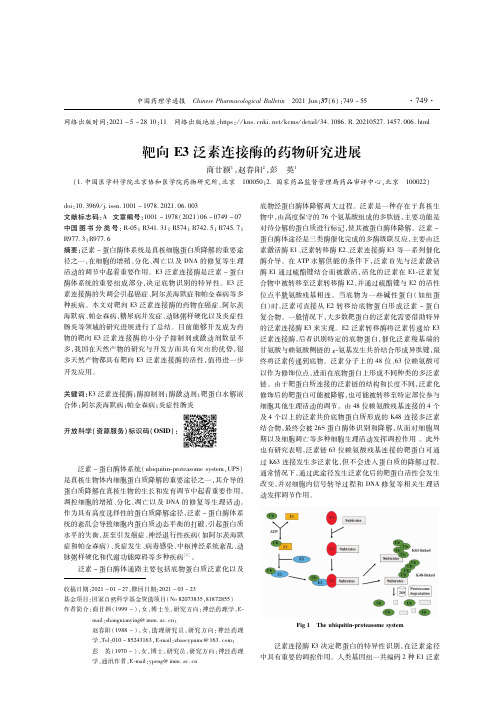
网络出版时间:2021-5-2810:11 网络出版地址:https://kns.cnki.net/kcms/detail/34.1086.R.20210527.1457.006.html靶向E3泛素连接酶的药物研究进展商廿颍1,赵春阳2,彭 英1(1.中国医学科学院北京协和医学院药物研究所,北京 100050;2.国家药品监督管理局药品审评中心,北京 100022)收稿日期:2021-01-27,修回日期:2021-03-23基金项目:国家自然科学基金资助项目(No82073835,81872855)作者简介:商廿颍(1999-),女,博士生,研究方向:神经药理学,Email:shangnianying@imm.ac.cn;赵春阳(1988-),女,助理研究员,研究方向:神经药理学,Tel:010-85243163,E mail:zhaocypumc@163.com;彭 英(1970-),女,博士,研究员,研究方向:神经药理学,通讯作者,E mail:ypeng@imm.ac.cndoi:10.3969/j.issn.1001-1978.2021.06.003文献标志码:A文章编号:1001-1978(2021)06-0749-07中国图书分类号:R 05;R341 31;R574;R742 5;R745 7;R977 3;R977 6摘要:泛素-蛋白酶体系统是真核细胞蛋白质降解的重要途径之一,在细胞的增殖、分化、凋亡以及DNA的修复等生理活动的调节中起着重要作用。
E3泛素连接酶是泛素-蛋白酶体系统的重要组成部分,决定底物识别的特异性。
E3泛素连接酶的失调会引起癌症、阿尔茨海默症和帕金森病等多种疾病。
本文对靶向E3泛素连接酶的药物在癌症、阿尔茨海默病、帕金森病、糖尿病并发症、动脉粥样硬化以及炎症性肠炎等领域的研究进展进行了总结。
目前能够开发成为药物的靶向E3泛素连接酶的小分子抑制剂或激动剂数量不多,我国在天然产物的研究与开发方面具有突出的优势,很多天然产物都具有靶向E3泛素连接酶的活性,值得进一步开发应用。
植物中E3泛素连接酶基因的研究进展

植物中 E 3 泛素连接酶基 因的研究进展
孙 秀 侯和胜 辽 宁师 范大 学生 命科 学学 院 辽宁 大连 1 1 6 0 8 1
辽 宁省植 物生 物工 程重 点实 验室 辽宁 大连 1 1 6 0 8 1
摘要: E 3泛素连接酶 ( u b i q u i t i n —l i g a s e e n z y m e s ) 是一个种 类繁 多的蛋 白大家族 ,在 整个 泛素蛋 白质 降解途径 中,E 3可 以直接 或间接 地促进泛素转移 到靶 蛋 白上,在此途径 中起到特异性识别靶蛋 白作 用。本文从 E 3泛素连 接 酶基 因的生物学特性、基 因克隆及表达调控方面,分析 该领域 的研 究进展 。 关 键 词 :泛 素 连 接 酶 E 3 :基 因 克 隆 :基 因表 达
( u bi q u i t i n -p r o t e i n 1 i g a s e) 。
其编码 的 S p l l 1蛋 白 具有 E 3泛 素 连 接 。 酶 的活 性 , 该 活 性 依 赖于完整 的 U — b o x结构域 。该基 因的突变会 导致水稻开花期 延迟和细胞程序性死 亡加速 。 姜颖等根据 O s G W 2 的e D N A 序列,
胁 迫反 应 、防御 反 应 、信 号 传 导 等 。水 稻 O s D I S I编码 的 一 个
在蛋 白质 降解 的过程 中,E 3 酶特异 的识别 、结合底物蛋 白,调节靶 蛋白的降解代谢从而决定 了它在泛素化 降解蛋 白 质选择方面发挥 的至关重要 的作用 。近年来 ,在藻类与高等 植物 中 E 3 在 调 控 生 长 发 育及 应 对 逆 境 胁 迫 等 方 面 的研 究 取 得 了较 大 进 展 , 但是仍然有很多 E 3蛋 白质 的 功 能 不是 很清 楚 。 因此 , 本文着重介绍 了藻类与高等植物 E 3 泛 素连接酶基因的 国内外研 究情况 , 以期能为今后 E 3 泛 素连接 酶基 因的研 究提 供有价值参考 。
《E3泛素连接酶UBR5在卵巢癌细胞ES-2中的功能初探》范文
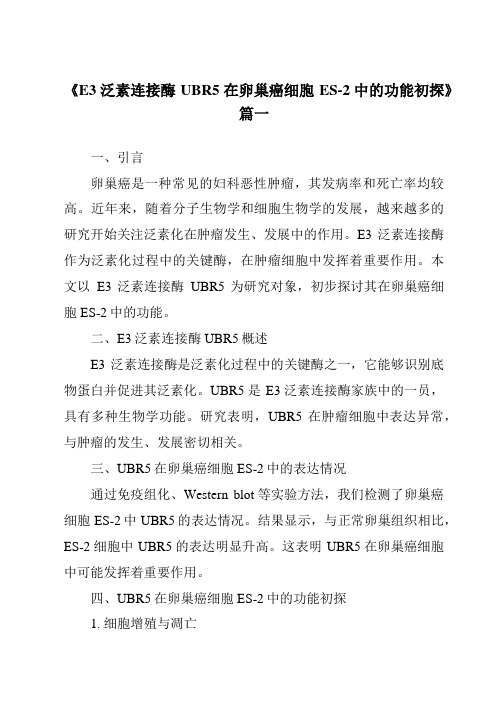
《E3泛素连接酶UBR5在卵巢癌细胞ES-2中的功能初探》篇一一、引言卵巢癌是一种常见的妇科恶性肿瘤,其发病率和死亡率均较高。
近年来,随着分子生物学和细胞生物学的发展,越来越多的研究开始关注泛素化在肿瘤发生、发展中的作用。
E3泛素连接酶作为泛素化过程中的关键酶,在肿瘤细胞中发挥着重要作用。
本文以E3泛素连接酶UBR5为研究对象,初步探讨其在卵巢癌细胞ES-2中的功能。
二、E3泛素连接酶UBR5概述E3泛素连接酶是泛素化过程中的关键酶之一,它能够识别底物蛋白并促进其泛素化。
UBR5是E3泛素连接酶家族中的一员,具有多种生物学功能。
研究表明,UBR5在肿瘤细胞中表达异常,与肿瘤的发生、发展密切相关。
三、UBR5在卵巢癌细胞ES-2中的表达情况通过免疫组化、Western blot等实验方法,我们检测了卵巢癌细胞ES-2中UBR5的表达情况。
结果显示,与正常卵巢组织相比,ES-2细胞中UBR5的表达明显升高。
这表明UBR5在卵巢癌细胞中可能发挥着重要作用。
四、UBR5在卵巢癌细胞ES-2中的功能初探1. 细胞增殖与凋亡通过MTT、流式细胞术等实验方法,我们初步探讨了UBR5对卵巢癌细胞ES-2增殖与凋亡的影响。
结果显示,抑制UBR5的表达能够显著抑制细胞的增殖并促进细胞的凋亡。
这表明UBR5可能具有促进卵巢癌细胞增殖的作用。
2. 细胞周期与迁移通过细胞周期实验和划痕实验等方法,我们进一步研究了UBR5对卵巢癌细胞周期和迁移的影响。
结果显示,抑制UBR5的表达能够导致细胞周期停滞并降低细胞的迁移能力。
这表明UBR5可能参与调控卵巢癌细胞的周期和迁移过程。
五、讨论根据实验结果,我们初步得出以下结论:在卵巢癌细胞ES-2中,E3泛素连接酶UBR5的表达升高,可能与卵巢癌的发生、发展密切相关。
抑制UBR5的表达能够显著抑制细胞的增殖、促进细胞的凋亡,并导致细胞周期停滞和迁移能力降低。
这些结果表明,UBR5在卵巢癌细胞中具有促进肿瘤发生、发展的作用。
植物含跨膜域RING E3泛素连接酶研究进展
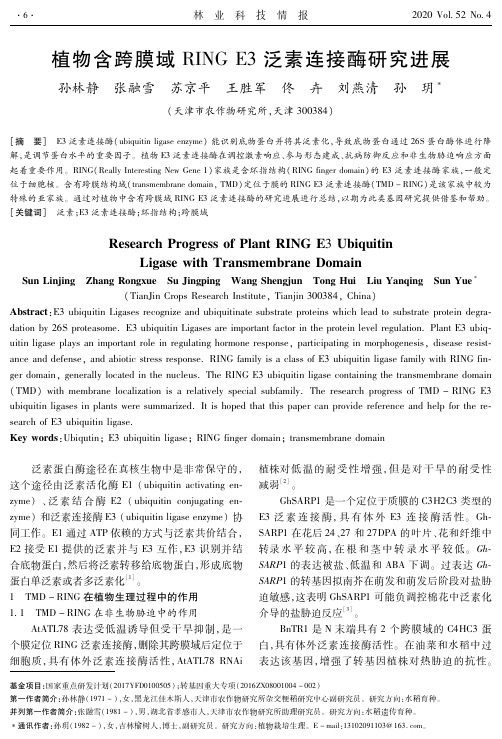
植物含跨膜域RINGE3泛素连接酶研究进展孙林静 张融雪 苏京平 王胜军 佟 卉 刘燕清 孙 癑(天津市农作物研究所,天津300384)[摘 要] E3泛素连接酶(ubiquitinligaseenzyme)能识别底物蛋白并将其泛素化,导致底物蛋白通过26S蛋白酶体进行降解,是调节蛋白水平的重要因子。
植物E3泛素连接酶在调控激素响应、参与形态建成、抗病防御反应和非生物胁迫响应方面起着重要作用。
RING(ReallyInterestingNewGene1)家族是含环指结构(RINGfingerdomain)的E3泛素连接酶家族,一般定位于细胞核。
含有跨膜结构域(transmembranedomain,TMD)定位于膜的RINGE3泛素连接酶(TMD-RING)是该家族中较为特殊的亚家族。
通过对植物中含有跨膜域RINGE3泛素连接酶的研究进展进行总结,以期为此类基因研究提供借鉴和帮助。
[关键词] 泛素;E3泛素连接酶;环指结构;跨膜域ResearchProgressofPlantRINGE3UbiquitinLigasewithTransmembraneDomainSunLinjing ZhangRongxue SuJingping WangShengjun TongHui LiuYanqing SunYue(TianJinCropsResearchInstitute,Tianjin300384,China)Abstract:E3ubiquitinLigasesrecognizeandubiquitinatesubstrateproteinswhichleadtosubstrateproteindegra dationby26Sproteasome.E3ubiquitinLigasesareimportantfactorintheproteinlevelregulation.PlantE3ubiq uitinligaseplaysanimportantroleinregulatinghormoneresponse,participatinginmorphogenesis,diseaseresist anceanddefense,andabioticstressresponse.RINGfamilyisaclassofE3ubiquitinligasefamilywithRINGfin gerdomain,generallylocatedinthenucleus.TheRINGE3ubiquitinligasecontainingthetransmembranedomain(TMD)withmembranelocalizationisarelativelyspecialsubfamily.TheresearchprogressofTMD-RINGE3ubiquitinligasesinplantsweresummarized.Itishopedthatthispapercanprovidereferenceandhelpforthere searchofE3ubiquitinligase.Keywords:Ubiqutin;E3ubiquitinligase;RINGfingerdomain;transmembranedomain基金项目:国家重点研发计划(2017YFD0100505);转基因重大专项(2016ZX08001004-002)第一作者简介:孙林静(1971-),女,黑龙江佳木斯人,天津市农作物研究所杂交粳稻研究中心副研究员。
E3泛素连接酶Arkadia的结构特征、生物学功能及其在疾病发生发展中的应用
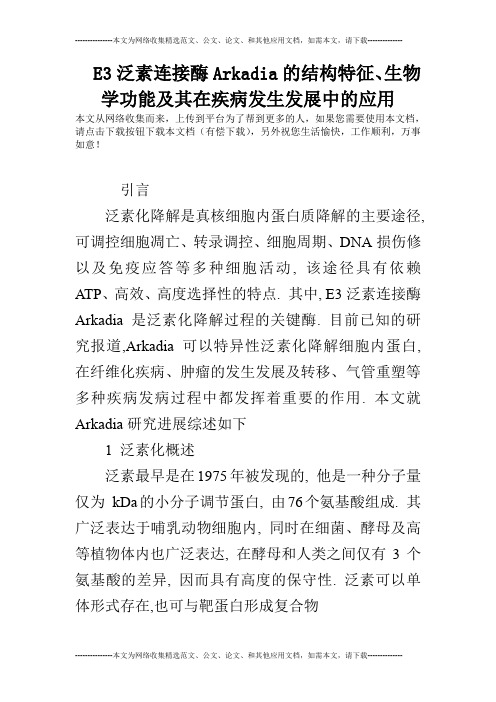
E3泛素连接酶Arkadia的结构特征、生物学功能及其在疾病发生发展中的应用本文从网络收集而来,上传到平台为了帮到更多的人,如果您需要使用本文档,请点击下载按钮下载本文档(有偿下载),另外祝您生活愉快,工作顺利,万事如意!引言泛素化降解是真核细胞内蛋白质降解的主要途径, 可调控细胞凋亡、转录调控、细胞周期、DNA损伤修以及免疫应答等多种细胞活动, 该途径具有依赖ATP、高效、高度选择性的特点. 其中, E3泛素连接酶Arkadia是泛素化降解过程的关键酶. 目前已知的研究报道,Arkadia可以特异性泛素化降解细胞内蛋白, 在纤维化疾病、肿瘤的发生发展及转移、气管重塑等多种疾病发病过程中都发挥着重要的作用. 本文就Arkadia研究进展综述如下1 泛素化概述泛素最早是在1975年被发现的, 他是一种分子量仅为kDa的小分子调节蛋白, 由76个氨基酸组成. 其广泛表达于哺乳动物细胞内, 同时在细菌、酵母及高等植物体内也广泛表达, 在酵母和人类之间仅有3个氨基酸的差异, 因而具有高度的保守性. 泛素可以单体形式存在,也可与靶蛋白形成复合物直到1982年, Ciechanover等对泛素化进行了更为具体的描述. 泛素化是指泛素分子在一系列酶作用下, 对靶蛋白进行特异性修饰的3步酶学反应过程. 首先, E1泛素激活酶通过水解ATP获得能量, 激活泛素分子, 进而实现泛素分子与E1泛素激活酶的共价结合; 然后在E2泛素结合酶的协助下, 泛素分子由E1泛素激活酶传递给E2结合酶; E3泛素连接酶再将与E2泛素结合酶共价结合的泛素分子传递给靶蛋白, 靶蛋白经过多次泛素化过程, 被多个泛素分子标记, 形成多聚泛素链; 最终, 被多聚泛素链所标记的靶蛋白被26S 蛋白酶体降解为小分子的多肽片段, 同时释放游离的可重新利用的泛素分子. 在体内, 泛素化为一动态过程, 与其他转录后修饰过程一样, 可影响细胞内的多个信号传导过程. 泛素化与去泛素化能否保持一定的平衡对于维持机体正常的生理状态具有非常重大的意义.2 E3泛素连接酶Arkadia的结构特征E3泛素连接酶决定了靶蛋白底物的特异性, 是泛素化过程中起决定作用的关键. 目前,已知的E3泛素连接酶有600多种, 根据其结构和功能的不同, 可以分为4类: HECT结构域E3酶、RING结构域E3酶、N末端规则E3酶、及环指相关E3酶[. Arkadia是一种环形E3泛素连接酶, 广泛表达于成年哺乳动物组织中,如包括睾丸、脾脏、胰腺、肺脏、肾脏、肝脏及心脏等. 2001年Niederländer等[30]及其同事首先对Arkadia进行了报道, 他们的研究发现Arkadia可增强Nodal信号通路, 诱导Node分子形成, 这在胚胎早期发生过程中发挥着非常重要的作用.Arkadia是由994个氨基酸开放阅读框架构成的蛋白, 编码基因为RNF111 ; 他具有泛素结合酶的RING结构域及靶蛋白识别结构, 其N-末端时多个核定位信号, C-末端即是具有特征性结构-RING finger结构域. RING-finger 结构域是指70个氨基酸中的8个氨基酸(半胱氨酸和组氨酸)通过与锌离子螯合作用形成C3H2C3(RING-H2)或C3HIC4(RING-HC)构型.其氨基酸序列为: Cys-X2-Cys-Xn(9-39)-Cys-Xl~3-His-X2~3-Cys-X2-Cys -Xn(4-48)-Cys-X2-Cys(C2HC4)(X可以是任何氨基酸残基, 但在特定的位置还有特定的氨基酸残基), Cys 和His分别代表锌结合残基半胱氨酸和组氨酸, 并且每一环指结构域连有两个锌离子.3 Arkadia在信号通路中的作用/Smad信号通路中的作用b Arkadia在TGF- ,b(transforming growth factor-b Arkadia是一种细胞内蛋白, 可以通过泛素化降解细胞内蛋白而发挥增强转化生长因子)信号通路的作用. 与其他E3泛素连接酶所不同的是,Arkadia与Smad1、Smad2、Smad4、Smad5、Smad8分子不存在相互作用,bTGF- 信号通路中的抑制性分子,b仅与Smad6、Smad7具有较强的相互作用; 而Smad6分子主要在BMP信号通路发挥重要作用. Smad7分子是TGF- 、activin、nodal信号通路的激活. 因此,b超家族的Ⅰ型受体相结合, 抑制Smad2、Smad3的活化, 从而抑制TGF-b可以与TGF- 信号通路的转录活性主要是通过泛素化降解Smad7分子而实现的. 除Smad7分子以外,bArkadia增强TGF- Arkadia还可以通过降解P-Smad2/3分子发挥增强Nodal 信号通路的作用.另外, Arkadia还可以降解c-Ski/SnoN, 信号通路下游靶基因的转录. 例如,在胚胎细胞中,b去除非活化状态的R-Smad复合体, 使得活化状态的R-Smad复合体与靶基因相结合, 进而促进TGF- 信号通路下游基因的转录.因此,bArkadia的表达缺失虽可募集P-Smad2/3分子, 但却不能启动TGF- 通路的抑制因子, 如Smad7、C-ski及SnoN,b/Smad信号通路, 主要是通过泛素化降解TGF-bArkadia参与调节TGF- 信号.b来放大TGF- Arkadia在骨形态发生蛋白-7/Smads信号通路中的作用超家族的成员之一,在细胞增殖及成骨细胞分化的过程中都发挥着非常重要的作用. 其中, Smads蛋白是骨形态发生蛋白-7(boneb BMPs是TGF- morphogenetic protein-7,BMP-7)/Smads信号通路下游重要的调节因子. 首先, BMP-7蛋白与丝氨酸/苏氨酸激酶Ⅰ型和Ⅱ型受体结合形成多聚复合物, 而后结合Smads蛋白(如Smad1/5/8)发挥信号传导作用.Smad6及Smad7是BMP-7/Smads信号通路中重要的抑制分子, 信号通路的抑制分子.b构成一个重要的负反馈的环路; 其中Smad7既是BMP-7/Smads信号通路的抑制分子, 又是TGF- 信号通路的抑制作用相对较弱, 却可以有效地阻断BMP-7/Smads信号通路.b但Smad6对于TGF- Tsubakihara等的研究揭示了在BMP诱导成骨细胞分化过程中, Arkadia的缺失会导致成骨细胞分化明显减少. 他们的研究表明Arkadia主要通过降解Smad6来发挥正向调控BMP-7/Smads信号通路的作用.Arkadia在EGF信号通路中的作用Arkadia信号通路, 在表皮生长因子(epidermal growth factor, EGF)信号通路中也发挥着重要的作用.b不仅仅可以调控TGF- Mizutani等研究发现, Arkadia可以与AP2复合体u2亚基的C-末端相结合, 促进u2亚基的泛素化, 进而可以调节内皮生长因子受体(epidermal growthfactor receptor, EGFR)的介导的内吞作用. 因此,Arkadia可以通过调节EGFR的内吞作用来发挥调控EGF信号通路的作用.4 Arkadia在疾病发生发展中的作用Arkadia与纤维化Arkadia信号通路相关疾病的发生发展过程中发挥着重要的作用.b/Smads信号通路, 故Arkadia在与TGF-b 能有效地增强TGF- 是纤维化发生过程中的关键因子, 因此, Arkadia可能会参与纤维化发生发展的过程. Liu 等的研究指出,bTGF- 刺激之后, Arkadia的mRNA表达水平明显升高, 而且用小干扰RNA干扰掉Arkadia 之后,b人的正常肾小管上皮细胞在TGF- -SMA)的表达水平出现明显的降低,a-smooth muscle actin, a-平滑肌肌动蛋白(a肾脏因此Arkadia在肾小管上皮细胞间质转化过程中有着非常重要的作用; 他们的另一项研究发现: 在肾小管间质纤维化的大鼠模型中, Smad7的mRNA水平升高, 但蛋白水平却降低, 他们认为Arkadia可以通过降解Smad7促进肾小管上皮细胞向间质细胞转化; Gai等的研究也进一步证实了Arkadia 可以促进间质上皮转化这一观点.Arkadia与肿瘤Arkadia与消化系肿瘤: Arkadia在消化系肿瘤的发生发展过程中发挥着重要的作用. Sharma等研究发现Arkadia在鼠的结肠上皮细胞中表达量较高, 且在Arkadia缺失的小鼠患结直肠癌的风险远远大于野生型小鼠; 因此Arkadia作为一种肿瘤抑制因子可以有效的抑制结直肠癌的发生发展. 同时, 信号通路而实现的. 此外,b他们认为Arkadia这一抑制结直肠癌发生发展的作用主要是通过募集SnoN分子抑制TGF- 在20种人类肿瘤细胞中也检测到Arkadia的泛素化表达, 因此认为Arkadia或许参与弥漫性胃癌的发展过程.Arkadia与肺部肿瘤: 体外研究[56]发现,Arkadia 在肺肿瘤细胞NCI-H460中稳定表达, 且可明显地抑制该细胞的生长; 但在体外实验中,Arkadia却不能抑制小鼠肺部肿瘤的发展. 另有研究报道Arkadia可以加速乳腺癌及肺癌鼠的肿瘤转移, 其主要机制是因为Arkadia可以降解c-Ski, 从而发挥促进间质上皮转移的作用;Briones-Orta等利用3种不同的肿瘤细胞进行了研究, 研究发现Arkadia被干扰之后, 肿瘤细胞在肺内的定植明显受到抑制, 他们得出这样的结论: Arkadia虽不能调控肿瘤的生长, 但在肿瘤细胞的定植及早期转移过程中却有着举足轻重的作用.Arkadia与气管重塑哮喘是一种气道慢性炎性疾病, 反复发作的炎症反应致使气管重塑, 作为一种致纤维化因子,b主要表现为上皮下纤维化形成、肌细胞增生、上皮损伤、杯状细胞化生、水肿及新生血管增加. TGF- 信号通路的调控因子, 在气管重塑过程中发挥着重要的作用.b而Arkadia作为TGF- 信号通路, 进而促进气管重塑.bLi等发现Arkadia通过降低Smad7、noN/Ski蛋白表达可以显著增强TGF- 他们的研究结果预示着Arkadia或许可以作为气管重塑治疗的新的切入点, 但是具体的机制还有待于更深入的研究.5 结论信号通路的作用;b信号通路转录活性, 继而放大TGF-bArkadia具有增强TGF- 还可以通过降解Smad6分子起到增强BMPs/Smad信号通路的作用, 同时也可以发挥调控EGF信号通路的作用. 此外, Arkadia在人类多种疾病的发生发展过程中都发挥着举足轻重的作用. 以上结果预示着Arkadia或许可以作为疾病治疗的新靶点, 但是其在疾病发生发展中的具体作用还有待于进一步的深入研究.本文从网络收集而来,上传到平台为了帮到更多的人,如果您需要使用本文档,请点击下载按钮下载本文档(有偿下载),另外祝您生活愉快,工作顺利,万事如意!。
e3泛素连接酶识别的基序
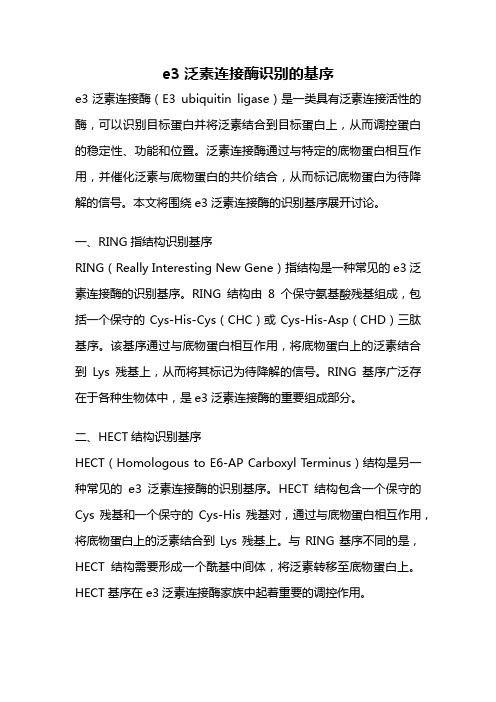
e3泛素连接酶识别的基序e3泛素连接酶(E3 ubiquitin ligase)是一类具有泛素连接活性的酶,可以识别目标蛋白并将泛素结合到目标蛋白上,从而调控蛋白的稳定性、功能和位置。
泛素连接酶通过与特定的底物蛋白相互作用,并催化泛素与底物蛋白的共价结合,从而标记底物蛋白为待降解的信号。
本文将围绕e3泛素连接酶的识别基序展开讨论。
一、RING指结构识别基序RING(Really Interesting New Gene)指结构是一种常见的e3泛素连接酶的识别基序。
RING结构由8个保守氨基酸残基组成,包括一个保守的Cys-His-Cys(CHC)或Cys-His-Asp(CHD)三肽基序。
该基序通过与底物蛋白相互作用,将底物蛋白上的泛素结合到Lys残基上,从而将其标记为待降解的信号。
RING基序广泛存在于各种生物体中,是e3泛素连接酶的重要组成部分。
二、HECT结构识别基序HECT(Homologous to E6-AP Carboxyl Terminus)结构是另一种常见的e3泛素连接酶的识别基序。
HECT结构包含一个保守的Cys残基和一个保守的Cys-His残基对,通过与底物蛋白相互作用,将底物蛋白上的泛素结合到Lys残基上。
与RING基序不同的是,HECT结构需要形成一个酰基中间体,将泛素转移至底物蛋白上。
HECT基序在e3泛素连接酶家族中起着重要的调控作用。
三、F-box结构识别基序F-box结构是e3泛素连接酶复合物的一个重要组成部分,用于识别底物蛋白。
F-box结构包含一个保守的F-box基序和一个底物识别结构域。
F-box基序与其他蛋白相互作用,将底物蛋白上的泛素结合到Lys残基上。
底物识别结构域则通过与底物蛋白特定的结构域相互作用,实现对底物蛋白的识别和选择性降解。
四、PDZ结构识别基序PDZ(PSD-95/Dlg/ZO-1)结构是一种常见的蛋白互作结构域,也参与了e3泛素连接酶的识别。
E3泛素连接酶在结直肠癌中的作用机制研究进展
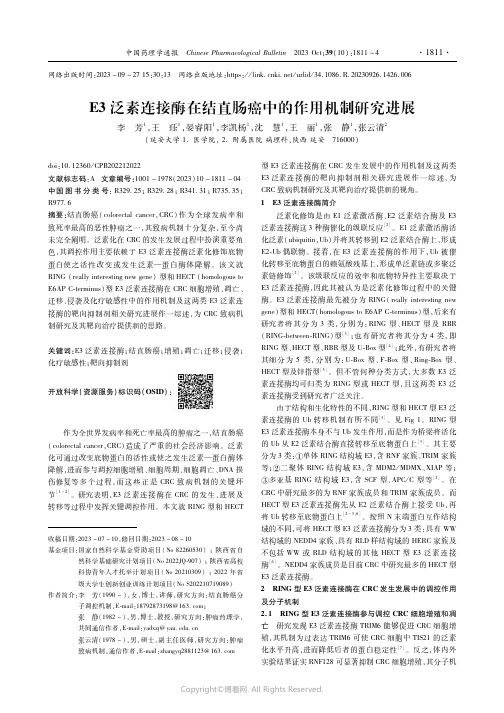
网络出版时间:2023-09-2715:30:13 网络出版地址:https://link.cnki.net/urlid/34.1086.R.20230926.1426.006E3泛素连接酶在结直肠癌中的作用机制研究进展李 芳1,王 珏1,晏睿阳1,李凯杨1,沈 慧1,王 丽1,张 静1,张云清2(延安大学1.医学院,2.附属医院病理科,陕西延安 716000)收稿日期:2023-07-10,修回日期:2023-08-10基金项目:国家自然科学基金资助项目(No82260530);陕西省自然科学基础研究计划项目(No2022JQ 907);陕西省高校科协青年人才托举计划项目(No20210309);2022年省级大学生创新创业训练计划项目(NoS202210719089)作者简介:李 芳(1990-),女,博士,讲师,研究方向:结直肠癌分子调控机制,E mail:18792873198@163.com;张 静(1982-),男,博士,教授,研究方向:肿瘤药理学,共同通信作者,E mail:yadxzj@yau.edu.cn张云清(1978-),男,硕士,副主任医师,研究方向:肿瘤致病机制,通信作者,E mail:zhangyq2881123@163.comdoi:10.12360/CPB202212022文献标志码:A文章编号:1001-1978(2023)10-1811-04中国图书分类号:R329 25;R329 28;R341 31;R735 35;R977 6摘要:结直肠癌(colorectalcancer,CRC)作为全球发病率和致死率最高的恶性肿瘤之一,其致病机制十分复杂,至今尚未完全阐明。
泛素化在CRC的发生发展过程中扮演重要角色,其调控作用主要依赖于E3泛素连接酶泛素化修饰底物蛋白使之活性改变或发生泛素—蛋白酶体降解。
该文就RING(reallyinterestingnewgene)型和HECT(homologoustoE6APC terminus)型E3泛素连接酶在CRC细胞增殖、凋亡、迁移、侵袭及化疗敏感性中的作用机制及这两类E3泛素连接酶的靶向抑制剂相关研究进展作一综述,为CRC致病机制研究及其靶向治疗提供新的思路。
泛素连接酶E3

单泛素化修饰
单泛素化修饰
单泛素化修饰是一种调节信号可以引起靶蛋白的活性、定位以及蛋白质结构的改变从而对蛋白质的胞吞途径、 膜泡的出芽、组蛋白的修饰、基因的转录以及蛋白质核内的定位进行调节。单独的泛素本身并没有任何生物功能, 它只是一种分子标记蛋白,发挥作用必须在ATP提供能量的前提下依靠泛素途径的相关酶类及蛋白酶体。Guarino 等在杆状病毒中也发现了病毒编码的泛素,但与真核细胞中不同的是泛素在杆状病毒中以磷脂化的形式存在于出 芽型病毒粒子囊膜的内表面。杆状病毒中泛素的功能尚不清楚,据推测可能与病毒粒子的组装和出芽有关。
泛素化途径
泛素化途径
泛素蛋白酶体途径是己知的所有真核生物体内具有高度选择性的最为重要的蛋白质降解途径,因此有关泛素 化途径的研究于2004年获得诺贝尔化学奖。泛素化修饰涉及泛素激活酶E1、结合酶E2和泛素连接酶E3的一系列反 应:首先在ATP供能的情况下泛素激活酶E1激活泛素,然后将其转移到泛素结合酶E2上通过硫酯键与E2的活性位 点的Cys相连。E2可以直接将泛素转移到靶蛋白的Lys残基上,但一般靶蛋白的泛素化需要一个特异的泛素连接酶 E3。
泛素连接酶E3
己知的所有真核生物体内具Biblioteka 高度选择性的最为重要的蛋白质降解 途径
目录
01 泛素化途径
03 分类
02 单泛素化修饰 04 识别机制
基本信息
泛素蛋白酶体途径是己知的所有真核生物体内具有高度选择性的最为重要的蛋白质降解途径。真核细胞中泛 素化修饰后的靶蛋白可能被降解、可能被转移到细胞或细胞外的特定部位,也有可能导致靶蛋白的功能发生变化, 这主要取决于靶蛋白所加的泛素链的结构,以及泛素链的长短。泛素连接酶E3决定靶蛋白的特异性识别,在泛素 途径中具有重要的作用。泛素连接酶E3通过调控调节蛋白的泛素化过程参与细胞内的多种生理过程。所有的E3都 具有连接靶蛋白和特定E2的能力。
泛素连接酶E3
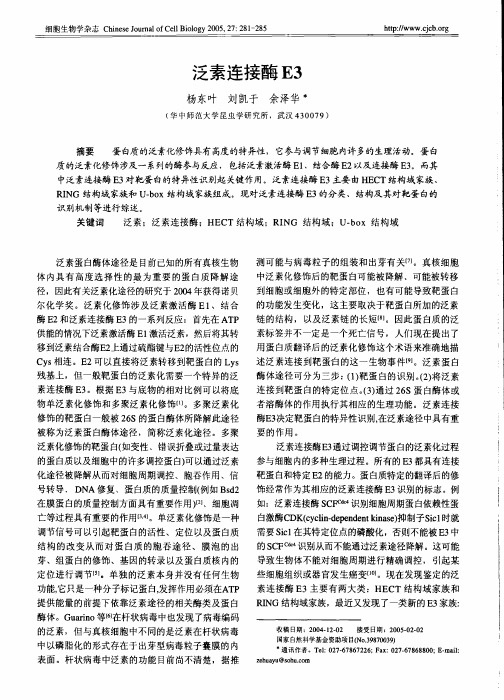
残基(Thr19、Cys820、Phe821和 Asn822)组成 的环 RING结构域的氨基酸序列为:Cys.X2.Cys. .Cys.
(即活性环)的中间 ,活性环的 4个氨基酸残基在结 X ̄_ 3-His-X2 3-Cys-X2一Cys-X -Cys-X2-Cys(C2HC4),
杨 东叶 等 :泛 素连 接酶 E3
测可能与病毒粒子的组装和出芽有关【7】。真核细胞 中泛 素化修饰后的靶 蛋白可能被降解 、可能被转移 到细胞或细胞外的特定 部位 ,也有可能导致靶蛋 白 的功能发生变化,这主要取 决于靶蛋 白所加的泛素 链的结构 ,以及泛素链 的长短【8】。因此蛋 白质的泛 素标签并不一定是一个死亡信号 ,人们现在提 出了 用蛋 白质翻译后的泛 素化修饰这个术语来准确地描 述泛素连接到靶蛋白 的这一生物事 件 。泛素蛋 白 酶体途径可分为三步:(1)靶蛋 白的识别。(2)将泛素 连接到靶蛋 白的特 定位点。(3)通过 26S蛋 白酶体或 者溶酶体 的作用执行其 相应的生理功能 。泛素连接 酶E3决定靶蛋 白的特异性识别,在泛素途径 中具有重 要 的作用 。
变化 ,UbcH7的活性位点 Cys与 RING结构域的氨 构域的蛋 白质,但 只有其中的 3种被证明具有 RING
基酸残基之 间的距离最近为 15 A,表明 RING结构 E3活性 。另外 3种无活性 原因可能是因为其 RING
成催化作用所 必需 的硫 酯键发挥作用 ,而 RING 结 通过 范德 华力与 HECT 结构域 的 N端 部分发生作
构域为E2和底物提供居 留位 点从而使 E2催化泛素转 用 。但活性环与 N端部分之间的作用被一有具有溶
移 到 底物 上 。
解力的通道在 N.C铰链处隔开,铰链通过非共价键
E3泛素连接酶调控植物抗病分子机理研究进展

E3泛素连接酶调控植物抗病分子机理研究进展作者:杨玖霞张浩王志龙王旭丽王国梁来源:《植物保护》2015年第04期摘要生物胁迫是影响我国农作物生产的重要因素,也是当前植物界研究方向涉及最为广泛的领域之一。
由泛素介导的降解途径是生物体内最为精细的调控体系,涉及对生物体的生长发育以及生物体对周围环境适应的调控等过程。
E3泛素连接酶因对底物有特异性识别作用,被认为是泛素化过程中最重要的组成部分。
依据其结构和功能的不同可以将E3泛素连接酶分为4个家族。
越来越多的研究表明这些不同的E3家族成员可以参与植物抗病免疫反应的各个过程。
本文在简要概括E3泛素连接酶分类的基础上综述了目前E3泛素连接酶参与调控植物抗病害方面研究进展,并对今后研究方向进行了展望,以期对抗病机理解析及抗病品种研发提供新思路。
关键词UPS;泛素化;E3泛素连接酶;PTI;ETI中图分类号:S 432.1文献标识码:ADOI:10.3969/j.issn.05291542.2015.04.001Recent progresses in the regulation mechanism ofE3 ligases in plant disease resistanceYang Jiuxia1,2,Zhang Hao1,2,Wang Zhilong1,Wang Xuli2,Wang Guoliang1,2(1. College of Agronomy, Hunan Agriculture University, Changsha410128, China; 2. State KeyLaboratory for Biology of Plant Diseases and Insect Pests, Institute of Plant Protection,Chinese Academy of Agricultural Sciences, Beijing100193, China)AbstractBiotic stress is an important factor that affects crop production in China. It is also one of the most widely studied areas in plant sciences. Degradation mediated by the ubiquitin proteasome system (UPS) is one of the most sophisticated regulation systems in eukaryotes, which is involved in plant growth and development and in response to abiotic and biotic stresses. E3 ligase is considered as a key enzyme in the UPS due to its specific interactions with its substrates. Based on the differences in structure and function, E3 ligases can be divided into four main classes. In this paper, we review the recent progresses in the regulation mechanism of E3 ligases in plant disease resistance and propose new research directions.Key wordsUPS;ubiquitination;E3 ligase;PTI;ETI植物与病原物在长期相互作用过程中协同进化。
SCF E3泛素化连接酶的研究进展

中的异 常激 活可以诱 导细胞 无限制 的增 殖和基 因组的不稳 定 , 因此 , E 3泛素化连接 酶复合物成 员可 以作为抗肿 瘤治疗 的靶点 。本 文主要介 绍 S C F E 3泛素化连接酶作为. 抗癌 药物的靶 点和新 型肿 瘤抑 帝 】 剂 ML N4 9 2 4的抗 肿瘤作 用。
酶体可以降解 超过 2 0 %的蛋 白Ⅲ 。
l S C F E 3连接酶 成分 作为 癌症治 疗 的靶点
多数 S C F E 3 连接酶组 分具有调 控细胞 周期 的功 能 、 基 因 转录功 能、 信号 转 导 和 D N A复 制 功 能。通 过靶 向 降解 底 物 S C F E 3 连接酶调控多种生物过程 。研 究表 明 , s C F E 3 泛 素化
关 键词 : S C F E 3 泛素化连接酶; 抗癌药物; ML N 4 9 2 4
泛 素蛋白酶系统 ( Ub i q u i t i n - p r o t e a s o me s y s t e m, UP S ) 通过 降解 不同的细胞 蛋 白调节多种生物过程 。因此 , 泛素蛋 白酶系 统 在维持体内平衡 和外 界刺 激的反应 中起着 重要 的作用 。泛 素蛋 白酶系统靶 向蛋 白降解需要底物 蛋 白的泛素化 , 即多步骤
1 ) , C u l l i n s , F - b o x蛋 白 和 R B X( R i n g b o x p r o t e i n - 1 ) / R O C
癌症 的发生 。S C F 复合物 种中包含 多种癌基 因 , 如S k p 2 , 可以 促进肿瘤抑制因子 降解 , 造成 自身在 癌症 中过表 达 , 如F b x w 7
( F - b o x a n d W D r e p e a t d o ma i n—c o n t a i n i n g 7) [ 引。
e3泛素连接酶泛素化底物的位点
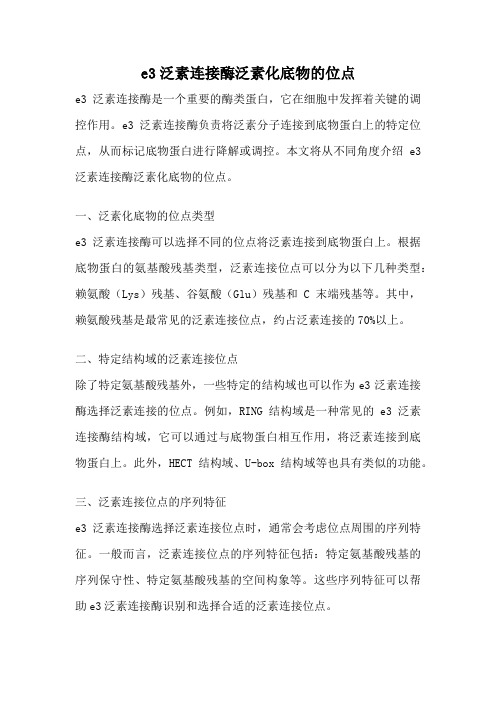
e3泛素连接酶泛素化底物的位点e3泛素连接酶是一个重要的酶类蛋白,它在细胞中发挥着关键的调控作用。
e3泛素连接酶负责将泛素分子连接到底物蛋白上的特定位点,从而标记底物蛋白进行降解或调控。
本文将从不同角度介绍e3泛素连接酶泛素化底物的位点。
一、泛素化底物的位点类型e3泛素连接酶可以选择不同的位点将泛素连接到底物蛋白上。
根据底物蛋白的氨基酸残基类型,泛素连接位点可以分为以下几种类型:赖氨酸(Lys)残基、谷氨酸(Glu)残基和C末端残基等。
其中,赖氨酸残基是最常见的泛素连接位点,约占泛素连接的70%以上。
二、特定结构域的泛素连接位点除了特定氨基酸残基外,一些特定的结构域也可以作为e3泛素连接酶选择泛素连接的位点。
例如,RING结构域是一种常见的e3泛素连接酶结构域,它可以通过与底物蛋白相互作用,将泛素连接到底物蛋白上。
此外,HECT结构域、U-box结构域等也具有类似的功能。
三、泛素连接位点的序列特征e3泛素连接酶选择泛素连接位点时,通常会考虑位点周围的序列特征。
一般而言,泛素连接位点的序列特征包括:特定氨基酸残基的序列保守性、特定氨基酸残基的空间构象等。
这些序列特征可以帮助e3泛素连接酶识别和选择合适的泛素连接位点。
四、泛素连接位点的结构特征除了序列特征外,泛素连接位点的结构特征也对e3泛素连接酶的选择起着重要的作用。
一些研究表明,泛素连接位点周围的局部结构可以通过与e3泛素连接酶的特定结构域相互作用,增加泛素连接的效率和特异性。
五、泛素连接位点的调控机制除了e3泛素连接酶的选择外,泛素连接位点的调控机制也是泛素化过程中的重要环节。
一些研究表明,底物蛋白的磷酸化、乙酰化等修饰可以影响泛素连接位点的选择和泛素连接的效率。
此外,一些蛋白质结构域的构象变化也可以调控泛素连接位点的选择。
六、泛素连接位点的生物学功能e3泛素连接酶选择泛素连接位点时,通常会考虑底物蛋白的生物学功能。
通过选择特定的泛素连接位点,e3泛素连接酶可以调控底物蛋白的稳定性、活性或与其他蛋白质的相互作用等,从而影响细胞的信号传导、代谢调控等生物学过程。
e3酶的结构 及种类
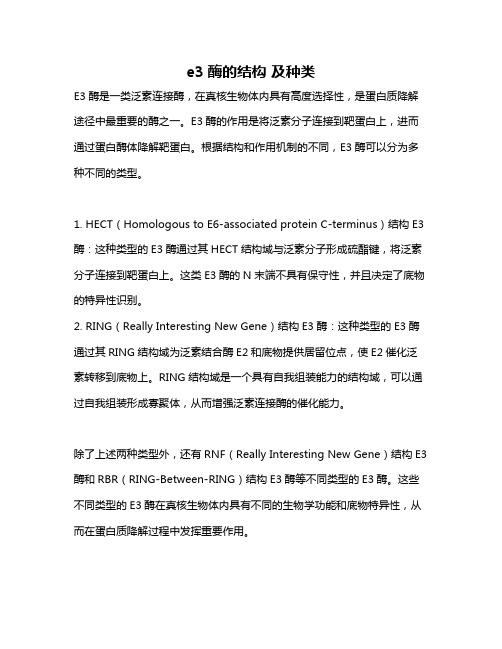
e3酶的结构及种类
E3酶是一类泛素连接酶,在真核生物体内具有高度选择性,是蛋白质降解途径中最重要的酶之一。
E3酶的作用是将泛素分子连接到靶蛋白上,进而通过蛋白酶体降解靶蛋白。
根据结构和作用机制的不同,E3酶可以分为多种不同的类型。
1. HECT(Homologous to E6-associated protein C-terminus)结构E3酶:这种类型的E3酶通过其HECT结构域与泛素分子形成硫酯键,将泛素分子连接到靶蛋白上。
这类E3酶的N末端不具有保守性,并且决定了底物的特异性识别。
2. RING(Really Interesting New Gene)结构E3酶:这种类型的E3酶通过其RING结构域为泛素结合酶E2和底物提供居留位点,使E2催化泛素转移到底物上。
RING结构域是一个具有自我组装能力的结构域,可以通过自我组装形成寡聚体,从而增强泛素连接酶的催化能力。
除了上述两种类型外,还有RNF(Really Interesting New Gene)结构E3酶和RBR(RING-Between-RING)结构E3酶等不同类型的E3酶。
这些不同类型的E3酶在真核生物体内具有不同的生物学功能和底物特异性,从而在蛋白质降解过程中发挥重要作用。
e3泛素连接酶基因

e3泛素连接酶基因
E3泛素连接酶基因是指编码泛素连接酶E3的基因。
泛素连接酶E3是泛素化酶系统中的一个重要组成部分,它负责将泛素蛋白连接到靶蛋白上,从而标记这些蛋白以便被降解或参与其他细胞生物学过程。
泛素连接酶E3的基因在人类基因组中有多个不同的家族,每个家族编码不同的泛素连接酶E3。
研究表明,泛素连接酶E3基因在细胞生长、分化、凋亡等生命活动中起着重要作用。
这些基因的突变或异常表达与许多疾病的发生和发展密切相关,如癌症、神经退行性疾病等。
因此,对泛素连接酶E3基因的研究具有重要意义。
在人类基因组中,已经发现了多个编码泛素连接酶E3的基因,如Mdm2、CHIP、Parkin等。
这些基因在调控细胞周期、DNA修复、细胞凋亡等方面发挥着重要作用。
人们通过研究这些基因的结构、功能和调控机制,可以更好地理解泛素化系统在细胞生物学中的作用,为相关疾病的治疗和药物研发提供重要的理论基础。
总的来说,泛素连接酶E3基因是泛素化酶系统中的重要组成部分,对于细胞生物学过程和多种疾病的发生发展具有重要意义。
对
这些基因的研究有助于揭示细胞生物学的机制,为疾病治疗和药物研发提供理论基础。
E3泛素连接酶HECTD3真核表达质粒的构建
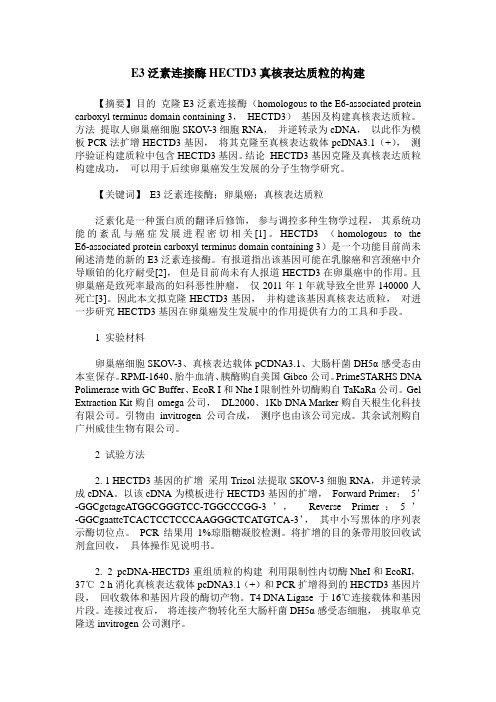
E3泛素连接酶HECTD3真核表达质粒的构建【摘要】目的克隆E3泛素连接酶(homologous to the E6-associated protein carboxyl terminus domain containing 3,HECTD3)基因及构建真核表达质粒。
方法提取人卵巢癌细胞SKOV-3细胞RNA,并逆转录为cDNA,以此作为模板PCR法扩增HECTD3基因,将其克隆至真核表达载体pcDNA3.1(+),测序验证构建质粒中包含HECTD3基因。
结论HECTD3基因克隆及真核表达质粒构建成功,可以用于后续卵巢癌发生发展的分子生物学研究。
【关键词】E3泛素连接酶;卵巢癌;真核表达质粒泛素化是一种蛋白质的翻译后修饰,参与调控多种生物学过程,其系统功能的紊乱与癌症发展进程密切相关[1]。
HECTD3 (homologous to the E6-associated protein carboxyl terminus domain containing 3)是一个功能目前尚未阐述清楚的新的E3泛素连接酶。
有报道指出该基因可能在乳腺癌和宫颈癌中介导顺铂的化疗耐受[2],但是目前尚未有人报道HECTD3在卵巢癌中的作用。
且卵巢癌是致死率最高的妇科恶性肿瘤,仅2011年1年就导致全世界140000人死亡[3]。
因此本文拟克隆HECTD3基因,并构建该基因真核表达质粒,对进一步研究HECTD3基因在卵巢癌发生发展中的作用提供有力的工具和手段。
1 实验材料卵巢癌细胞SKOV-3、真核表达载体pCDNA3.1、大肠杆菌DH5α感受态由本室保存。
RPMI-1640、胎牛血清、胰酶购自美国Gibco公司。
PrimeSTARHS DNA Polimerase with GC Buffer、EcoR I和Nhe I限制性外切酶购自TaKaRa公司。
Gel Extraction Kit购自omega公司,DL2000、1Kb DNA Marker购自天根生化科技有限公司。
E3泛素连接酶与人类疾病的关系研究
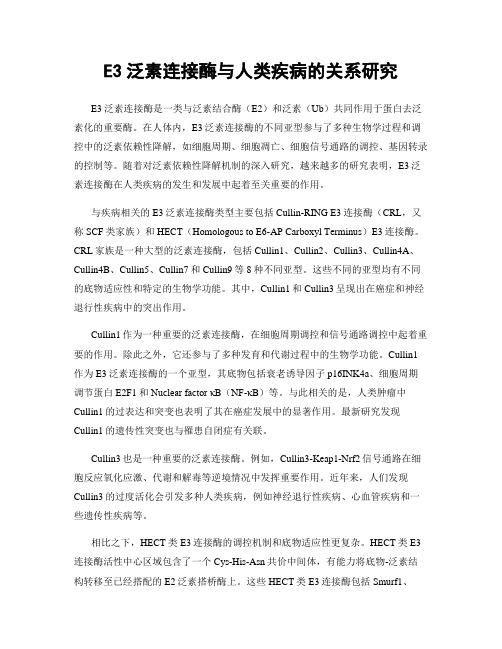
E3泛素连接酶与人类疾病的关系研究E3泛素连接酶是一类与泛素结合酶(E2)和泛素(Ub)共同作用于蛋白去泛素化的重要酶。
在人体内,E3泛素连接酶的不同亚型参与了多种生物学过程和调控中的泛素依赖性降解,如细胞周期、细胞凋亡、细胞信号通路的调控、基因转录的控制等。
随着对泛素依赖性降解机制的深入研究,越来越多的研究表明,E3泛素连接酶在人类疾病的发生和发展中起着至关重要的作用。
与疾病相关的E3泛素连接酶类型主要包括Cullin-RING E3连接酶(CRL,又称SCF类家族)和HECT(Homologous to E6-AP Carboxyl Terminus)E3连接酶。
CRL家族是一种大型的泛素连接酶,包括Cullin1、Cullin2、Cullin3、Cullin4A、Cullin4B、Cullin5、Cullin7和Cullin9等8种不同亚型。
这些不同的亚型均有不同的底物适应性和特定的生物学功能。
其中,Cullin1和Cullin3呈现出在癌症和神经退行性疾病中的突出作用。
Cullin1作为一种重要的泛素连接酶,在细胞周期调控和信号通路调控中起着重要的作用。
除此之外,它还参与了多种发育和代谢过程中的生物学功能。
Cullin1作为E3泛素连接酶的一个亚型,其底物包括衰老诱导因子p16INK4a、细胞周期调节蛋白E2F1和Nuclear factor κB(NF-κB)等。
与此相关的是,人类肿瘤中Cullin1的过表达和突变也表明了其在癌症发展中的显著作用。
最新研究发现Cullin1的遗传性突变也与罹患自闭症有关联。
Cullin3也是一种重要的泛素连接酶。
例如,Cullin3-Keap1-Nrf2信号通路在细胞反应氧化应激、代谢和解毒等逆境情况中发挥重要作用。
近年来,人们发现Cullin3的过度活化会引发多种人类疾病,例如神经退行性疾病、心血管疾病和一些遗传性疾病等。
相比之下,HECT类E3连接酶的调控机制和底物适应性更复杂。
E3泛素连接酶对卵巢癌细胞系SKOV3/DDP顺铂耐药性的影响
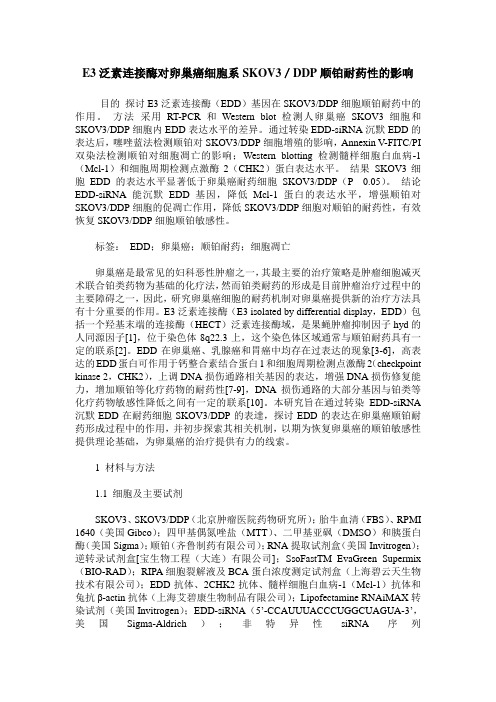
E3泛素连接酶对卵巢癌细胞系SKOV3/DDP顺铂耐药性的影响目的探讨E3泛素连接酶(EDD)基因在SKOV3/DDP细胞顺铂耐药中的作用。
方法采用RT-PCR和Western blot检测人卵巢癌SKOV3细胞和SKOV3/DDP细胞内EDD表达水平的差异。
通过转染EDD-siRNA沉默EDD的表达后,噻唑蓝法检测顺铂对SKOV3/DDP细胞增殖的影响,Annexin V-FITC/PI 双染法检测顺铂对细胞凋亡的影响;Western blotting检测髓样细胞白血病-1(Mcl-1)和细胞周期检测点激酶2(CHK2)蛋白表达水平。
结果SKOV3细胞EDD的表达水平显著低于卵巢癌耐药细胞SKOV3/DDP(P 0.05)。
结论EDD-siRNA能沉默EDD基因,降低Mcl-1蛋白的表达水平,增强顺铂对SKOV3/DDP细胞的促凋亡作用,降低SKOV3/DDP细胞对顺铂的耐药性,有效恢复SKOV3/DDP细胞顺铂敏感性。
标签:EDD;卵巢癌;顺铂耐药;细胞凋亡卵巢癌是最常见的妇科恶性肿瘤之一,其最主要的治疗策略是肿瘤细胞减灭术联合铂类药物为基础的化疗法,然而铂类耐药的形成是目前肿瘤治疗过程中的主要障碍之一,因此,研究卵巢癌细胞的耐药机制对卵巢癌提供新的治疗方法具有十分重要的作用。
E3泛素连接酶(E3 isolated by differential display,EDD)包括一个羟基末端的连接酶(HECT)泛素连接酶域,是果蝇肿瘤抑制因子hyd的人同源因子[1],位于染色体8q22.3上,这个染色体区域通常与顺铂耐药具有一定的联系[2]。
EDD在卵巢癌、乳腺癌和胃癌中均存在过表达的现象[3-6],高表达的EDD蛋白可作用于钙整合素结合蛋白1和细胞周期检测点激酶2(checkpoint kinase 2,CHK2),上调DNA损伤通路相关基因的表达,增强DNA损伤修复能力,增加顺铂等化疗药物的耐药性[7-9],DNA损伤通路的大部分基因与铂类等化疗药物敏感性降低之间有一定的联系[10]。
e3泛素连接酶与氨基酸稳态的关系
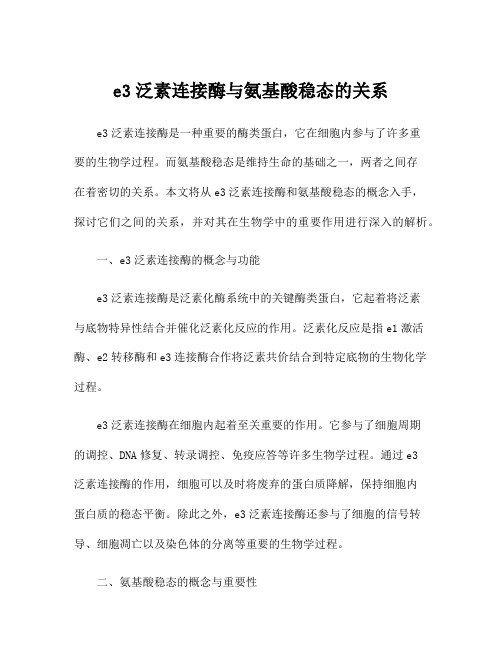
e3泛素连接酶与氨基酸稳态的关系e3泛素连接酶是一种重要的酶类蛋白,它在细胞内参与了许多重要的生物学过程。
而氨基酸稳态是维持生命的基础之一,两者之间存在着密切的关系。
本文将从e3泛素连接酶和氨基酸稳态的概念入手,探讨它们之间的关系,并对其在生物学中的重要作用进行深入的解析。
一、e3泛素连接酶的概念与功能e3泛素连接酶是泛素化酶系统中的关键酶类蛋白,它起着将泛素与底物特异性结合并催化泛素化反应的作用。
泛素化反应是指e1激活酶、e2转移酶和e3连接酶合作将泛素共价结合到特定底物的生物化学过程。
e3泛素连接酶在细胞内起着至关重要的作用。
它参与了细胞周期的调控、DNA修复、转录调控、免疫应答等许多生物学过程。
通过e3泛素连接酶的作用,细胞可以及时将废弃的蛋白质降解,保持细胞内蛋白质的稳态平衡。
除此之外,e3泛素连接酶还参与了细胞的信号转导、细胞凋亡以及染色体的分离等重要的生物学过程。
二、氨基酸稳态的概念与重要性氨基酸是构成蛋白质的基本单元,它们在维持生命和生长过程中起着至关重要的作用。
氨基酸的稳态是指细胞内外氨基酸浓度的平衡状态。
细胞需要不断地合成新的蛋白质,并在维持这些蛋白质的正常功能的同时,合理地利用旧蛋白质。
这就要求细胞内外氨基酸的浓度保持在一个相对稳定的水平上。
氨基酸稳态的打破将会导致蛋白质的合成和降解失衡,从而对细胞的正常生理功能产生不利影响。
因此,氨基酸稳态对于细胞的生存和生长具有非常重要的意义。
三、e3泛素连接酶与氨基酸稳态的关系e3泛素连接酶与氨基酸稳态之间有着密切的联系。
正常情况下,e3泛素连接酶能够将不需要的蛋白质标记并送往泛素-蛋白酶体降解系统进行降解。
这种过程可以保持细胞内蛋白质的稳态,防止蛋白质在细胞内积累产生异常。
而如果e3泛素连接酶功能异常或者发生突变,将导致大量的不需要的蛋白质无法被及时降解。
这将引起细胞内蛋白质的紊乱积累,打破细胞内氨基酸的稳态平衡。
从而影响细胞内蛋白质的合成和降解,引发一系列疾病。
- 1、下载文档前请自行甄别文档内容的完整性,平台不提供额外的编辑、内容补充、找答案等附加服务。
- 2、"仅部分预览"的文档,不可在线预览部分如存在完整性等问题,可反馈申请退款(可完整预览的文档不适用该条件!)。
- 3、如文档侵犯您的权益,请联系客服反馈,我们会尽快为您处理(人工客服工作时间:9:00-18:30)。
Plant Science 180(2011)775–782Contents lists available at ScienceDirectPlantSciencej o u r n a l h o m e p a g e :w w w.e l s e v i e r.c o m /l o c a t e /p l a n t s ciOverexpression of OsRDCP1,a rice RING domain-containing E3ubiquitin ligase,increased tolerance to drought stress in rice (Oryza sativa L.)Hansol Bae a ,1,Sung Keun Kim a ,1,Seok Keun Cho a ,Bin Goo Kang b ,Woo Taek Kim a ,∗a Department of Systems Biology,College of Life Science and Biotechnology,Yonsei University,Seoul 120-749,Republic of Korea bReSEAT Program,Korea Institute of Science and Technology Information,Seoul 130-741,Republic of Koreaa r t i c l e i n f o Article history:Received 5February 2011Received in revised form 21February 2011Accepted 21February 2011Available online 4March 2011Keywords:Drought stress E3ubiquitin ligase Oryza sativaOsRDCP1-overexpressing lines Rice osrdcp1knock-out mutant RING domaina b s t r a c tCaRma1H1was previously identified as a hot pepper drought-induced RING E3Ub ligase.We have identi-fied five putative proteins that display a significant sequence identity with CaRma1H1in the rice genome database (/cgi-bin/RiceGE ).These five rice paralogs possess a single RING motif in their N-terminal regions,consistent with the notion that RING proteins are encoded by a multi-gene family.Therefore,these proteins were named OsRDCPs (Oryza sativa RING domain-containing proteins).Among these paralogs,OsRDCP1was induced by drought stress,whereas the other OsRDCP members were constitutively expressed,with OsRDCP4transcripts expressed at the highest level in rice seedlings.osrdcp1loss-of-function knockout mutant and OsRDCP1-overexpressing transgenic rice plants were developed.Phenotypic analysis showed that wild-type plants and the homozygous osrdcp1G2mutant line displayed similar phenotypes under normal growth conditions and in response to drought stress.This may be due to complementation by other OsRDCP paralogs.In contrast,35S:OsRDCP1T2transgenic rice plants exhib-ited improved tolerance to severe water deficits.Although the physiological function of OsRDCP1remains unclear,there are several possible mechanisms for its involvement in a subset of physiological responses to counteract dehydration stress in rice plants.©2011Elsevier Ireland Ltd.All rights reserved.1.IntroductionTurnover of a wide range of eukaryotic proteins is regulated by the ubiquitin (Ub)-26S proteasome pathway.This pathway plays a critical role in the control of multiple cellular processes as diverse as cell cycle,differentiation,hormone responses,protein trafficking,and responses to environmental stresses [1–3].Multiple Ub chains are attached to the target proteins by E1,E2,and E3enzymes and serve as degradation tags,leading to the proteolysis of targeted proteins by the 26S proteasome complex [4,5].Based on subunit composition,E3s can be classified into two groups.The HECT and RING/U-box E3classes are comprised of single subunits,whereas the SCF and anaphase-promoting-complex (APC)E3ligases consist of multiple polypeptides [1–5].In most cases,E3Ub ligases are responsible for identifying specific target proteins.Abbreviations:ABA,abscisic acid;MeJA,methyl jasmonate;RT-PCR,reverse transcriptase-polymerase chain reaction;SA,salicylic acid;Ub,ubiquitin.∗Corresponding author.Tel.:+82221232661;fax:+8223125657.E-mail address:wtkim@yonsei.ac.kr (W.T.Kim).1These two authors equally contributed to this work and are listed in alphabetical order.A number of RING-containing proteins function as E3Ub ligases in responses to abiotic environmental stresses.Arabidopsis HOS1works as a negative regulator for cold-stress signal transduction [6,7],while XERICO participates positively in salt-and osmotic-stress responses through the overproduction of abscisic acid (ABA)[8].Arabidopsis SDIR1and DRIP RING E3Ub ligases are involved in the regulation of positive and negative drought-stress responses,respectively [9,10].Ryu et al.[11]recently reported that AtAIRP1RING E3is a positive regulator of an ABA-dependent defense mech-anism against drought stress.Compared to the studies of Arabidopsis RING E3ligases,research elucidating the roles of these Ub ligases in crop plants has been scarce.The hot pepper CaRma1H1RING E3ligase confers strong tolerance to dehydration stress when it is ectopically expressed in Arabidopsis [12].More recently,the rice OsDSG1RING protein was reported to regulate high-salt and drought stress responses [13].Collectively,these results are indicative of cellular functions of RING E3Ub ligases in defense against abiotic environmental stresses in higher plants.We aimed to unravel the physiological roles of RING E3Ub lig-ases with respect to abiotic stresses,such as water deficit.In this report,we used rice as a molecular genetic model system and identified five homologous OsRDCP (Oryza sativa RING domain-containing protein)family members,all of which contain a single0168-9452/$–see front matter ©2011Elsevier Ireland Ltd.All rights reserved.doi:10.1016/j.plantsci.2011.02.008776H.Bae et al./Plant Science180(2011)775–782RING motif in their N-terminal regions.Among these rice par-alogs,OsRDCP1was induced by drought stress.Loss-of-function rice mutant plants(osrdcp1)containing a T-DNA copy integrated into the OsRDCP1gene and OsRDCP1-overexpressing transgenic rice plants(35S:OsRDCP1)were developed.Phenotypic analysis showed that wild-type plants and the homozygous osrdcp1G2 mutant line displayed similar phenotypes under normal growth conditions and in response to drought stress.In contrast,OsRDCP1-overexpressing T2transgenic rice plants exhibited markedly improved tolerance to severe water deficits.Although the physi-ological function of OsRDCP1has not yet been determined,there are several possibilities for the involvement of OsRDCP1in a subset of physiological responses to counteract dehydration stress in rice plants.2.Materials and methods2.1.Plant materialsRice(O.sativa var.Japonica cv.Dongjin)seeds were germi-nated on Murashige and Skoog medium containing MS basal salts (Wako Pure Chemical,Osaka,Japan),3%sucrose,0.2%phytogel,and 0.55mM myo-inositol as described previously[14].Seedlings were grown for1–2weeks at27◦C under continuous light,transplanted to soil in a greenhouse,and raised to maturity.The rice mutant line osrdcp1that contained a T-DNA insertion within OsDRCP1was developed from a population of T-DNA-tagging lines produced from O.sativa var.Japonica cv.Dongjin[15,16]using a gene-specific primer M1(5 -TTGACTTTGCACACATAGGACA-3 )and a T-DNA right border primer LBa-1(5 -ACAAGCCGTAAGTGCAAGTG-3 ).Plants homozygous for the T-DNA insertion were identified through mul-tiple PCRs with primers M2(5 -CTGGTGCCATTGTATGGTCGT-3 ) and LBa-1.The35S:OsRDCP1transgenic rice plants overexpress-ing OsRDCP1under the control of the35S CaMV promoter were generated by Agrobacterium-mediated co-cultivation methods as previously earlier[17].Regenerated plants were grown in a green-house at approximately30◦C during the day and20◦C at night.The light/dark cycle in the greenhouse was14/10h[18].2.2.Reverse transcriptase-polymerase chain reaction(RT-PCR)RT-PCR was performed in25l reaction buffer(10mM Tris, pH8.0,50mM KCl,1.5mM MgCl2,0.01%gelatin,and200M deoxynucleotides)containing1l of thefirst-strand cDNA reaction products,1M gene-specific primer sets,and2.5units Taq poly-merase(Promega,Madison,WI,USA).Gene-specific primers were designed based on the nucleotide sequences of OsRDCP1,OsRDCP2, OsRDCP3,OsRDCP4,and OsRDCP5(Table1).PCR conditions con-sisted of25cycles of45s at95◦C,1min at60◦C,and90s at72◦C in an automatic thermal cycler(Perkin-Elmer/Cetus,Norwalk,CT, USA).PCR products were separated on1.2%agarose gels and visu-alized under UV light.2.3.Application of abiotic stresses and plant hormonesRice plants were subjected to various abiotic stresses based on the method of Cho et al.[19]with significant modifications as described previously[20].For drought stress treatments,rice seedlings were grown for2weeks on agar plates under light con-ditions,harvested,and dehydrated on Whatman3MMfilter paper at room temperature.The degree of water stress was determined as the decrease in the fresh weight(5–30%)of the seedlings.For high-salinity treatments,2-week-old whole seedlings were soaked in solution containing150mM NaCl for0,2,6,or24h with gentle shaking.For low-temperature treatments,2-week-old plants were incubated at4◦C for0,2,6,or24h.For hormone treatments,leaf Table1Primer sequences for RT-PCR and genotyping PCR.Gene Primer sequenceRT-PCROsRDCP1(Os04g44820)Forward5 -GGTTCTTTGTTCTTGTCAGTGCTG-3Reverse5 -GGAATGGGCACACCATTCAG-3 OsRDCP2(Os02g42690)Forward5 -TGAGACGGCAGCACATGGAG-3Reverse5 -TCACTACTTAACAGCGTCCGCTC-3 OsRDCP3(Os01g56070)Forward5 -CAGCATGTTGATGTGTTCTTGAAG-3Reverse5 -CTACAAACAAGACTTGCAACTGCAC-3 OsRDCP4(Os03g47500)Forward5 -GTTTCACTATGGGTATGGCCATG-3Reverse5 -CATGCAAATATTCTATGAACACTTCATG-3 OsRDCP5(Os12g43930)Forward5 -ATATGGACACGGCCACGGT-3Reverse5 -CTCTAGTTCATTCAGACAGAGCTTCC-3 OsRab16b(Os11g26780)Forward5 -ACAAGGGCAACAACCACCAG-3Reverse5 -GCTTGCAATGGCATCACAAG-3 OsActin(Os03g50885)Forward5 -GTCAGCAACTGGGATGATATGG-3Reverse5 -TCTCCTTGCTCATCCTGTCAG-3 Genotyping PCROsRDCP1M15 -TTGACTTTGCACACATAGGACA-3M25 -CTGGTGCCATTGTATGGTCGT-3 LBa-15 -ACAAGCCGTAAGTGCAAGTG-3tissues of4-week-old plants were sprayed with100M salicylic acid(SA),100M methyl jasmonate(MeJA),or100M ABA and harvested at different time points.For ethylene treatments,light-grown2-week-old intact plants were enclosed in6-l jars containing air or air plus50l/l ethylene for various time periods.Proper ethylene concentrations were confirmed by gas chromatography [21].2.4.RNA gel blot analysisTotal RNA was obtained from rice plants as described previ-ously[22].RNA(10g per lane)was separated by electrophoresis on1.0%-agarose gels,blotted onto nylon membranefilters(Amer-sham,Arlington Heights,IL,USA),and hybridized with32P-labeled cDNA probes for OsRDCP1,OsEXP,OsLEA3,OsPHGPX,or OsActin under high-stringency hybridization and washing conditions.Blots were visualized by autoradiography at−80◦C using Kodak XAR-5film and an intensifying screen.Hybridization signals were quanti-fied with a PhosphorImager(Fuji,Tokyo,Japan).2.5.In vitro ubiquitination assaysIn vitro ubiquitination assays were conducted as described pre-viously[23]with minor modifications.Briefly,500ng bacterially expressed MBP-OsRDCP1fusion protein was incubated with150l ubiquitination reaction buffer(50mM Tris–HCl,pH7.5,2.5mM MgCl2,and0.5mM DTT)containing4mM ATP and20ng each of human E1and human E2UbcH5B.Arabidopsis E1(UBA1)and Arabidopsis E2(UBC8)were previously used for our in vitro ubiqui-tination assays.However,in this study,we obtained better results of rice E3Ub ligase assay with human E1and human E2UbcH5B as described by Park et al.[24].Reaction mixtures were incubated at 30◦C for0–120min,separated by8%SDS–PAGE,and subjected to immuno-blotting using an anti-MBP antibody(New England Bio-Labs,Ipswich,MA,USA)as described previously[25].2.6.Phenotypic analysis of wild-type,osrtbp1mutant,and35S:OsRDCP1transgenic rice plantsWild-type,osrtbp1mutant,and various independent 35S:OsRTBP1transgenic rice plants were subjected to drought stress as described previously[12,23]with modifications.Six-week-old plants were grown in pots under greenhouse conditions. The soil was then allowed to dry by withholding water for15 days until plants displayed wilting.Dehydration sensitivity wasH.Bae et al./Plant Science180(2011)775–782777Fig.1.Identification offive homologous rice RING E3OsRDCP family members.(A)Schematic representation of predictedfive rice OsRDCP paralogs.The GenBank accession numbers of OsRDCP1,OsRDCP2,OsRDCP3,OsRDCP4,and OsRDCP5are Os04g44820,Os02g42690,Os01g56070,Os03g47500,and Os12g43930,respectively.N-terminal RING domain and C-terminal membrane-anchoring domain are indicated by green bars and red bars,respectively.(B)Sequence alignment of the RING domain of the OsRDCP paralogs.Amino acids identical in allfive proteins are shown in black.Amino-acid residues that are conserved in at least three of thefive sequences are shaded.Putative Zn2+-interacting Cys and His residues are indicated.The numbers on the right indicate the amino-acid residues.(C)Comparison of the predicted amino-acid sequences offive full-length rice OsRDCP paralogs.The green box and red box indicate N-terminal RING domain and C-terminal membrane-anchoring domain,respectively.(For interpretation of the references to color in thisfigure legend,the reader is referred to the web version of the article.)scored as the capacity of plants to resume growth when returned to normal water conditions with re-watering.3.Results and discussion3.1.Identification and expression offive homologous rice OsRDCP gene family membersCaRma1H1was previously identified as a hot pepper drought-induced RING E3Ub ligase[12].Transgenic Arabidopsis plants that ectopically expressed CaRma1H1were highly resistant to severe water deficits.Searches of the rice genome database (/cgi-bin/RiceGE)revealed that there are at leastfive putative proteins that display a significant sequence identity with CaRma1H1and Arabidopsis AtRma1[26]homologs (Fig.1A).Thesefive rice paralogs possess a single RING motif in their N-terminal regions(Fig.1B),consistent with the notion that RING proteins are encoded by a large multi-gene family[2,4,5].In addition,they contain a putative membrane-anchoring domain in their C-terminal regions.Thus,these paralogs were named OsRDCPs (O.sativa RING domain-containing proteins).The predicted OsRDCP paralogs were25–79%identical to each other at the amino acid level (Fig.1C).To examine whether these rice RING E3members were induced by water deficits,2-week-old rice seedlings were subjected to drought stress and expression of each member was monitored by RT-PCR using gene-specific primer sets(Table1).The degree of water stress was monitored as the loss of fresh weight(0–30%)of the seedlings.The results showed that,among thefive paralogs,778H.Bae et al./Plant Science180(2011)775–782Fig.2.RT-PCR analysis offive OsRDCP family members in rice seedlings.Light-grown2-week-old seedlings were subjected to drought stress.Expression of each gene member in shoot and root tissues was analyzed by RT-PCR using gene-specific primer sets(Table1).The degree of water stress was monitored as loss of seedling fresh weight(0or30%).Rice Rab16b was used as a positive control for a drought-induced gene and actin was used as a loading control.OsRDCP1was significantly induced by drought stress in both shoot and root tissues,while the other OsRDCP members were constitu-tively expressed(Fig.2).The level of the OsRDCP4transcript was the highest in rice seedlings.3.2.OsRDCP1is a drought-inducible RING E3Ub ligase in riceThe OsRDCP1gene(GenBank accession number AK070732)is located on chromosome4and contains one intron(2093bp)in the5 -untranslated region(Fig.3A).The coding region of OsRDCP1 is762bp and encodes253amino acids with a molecular mass of 28.1kDa and a calculated p I of7.2.Full-length OsRDCP1is37%, 29%,and31%identical to hot pepper CaRma1H1[12],Arabidopsis AtRma1[26],and human RING protein HsRma1[27],respectively (Fig.3B).In addition,the RING domain of OsRDCP1is48–78%iden-tical to those of hot pepper,Arabidopsis,and human RING proteins. Thesefindings suggest that the domain is critical for Ub ligase activ-ity in rice plants.Like CaRma1H1,AtRma1,and HsRma1,OsRDCP1 has a single putative membrane-anchoring domain in its extreme C-terminus,suggesting that it is a membrane-associated protein.These structural conservations suggest that OsRDCP1is a RING domain-containing E3Ub ligase.Therefore,we characterized the OsRDCP1gene in more detail at the molecular level.Since OsRDCP1 was identified initially as a homolog of water stress-induced hot pepper CaRma1H1,we hypothesized that the expression of OsRDCP1is modulated by abiotic stresses in rice plants.To test this hypothesis,the OsRDCP1mRNA accumulation profile was monitored by RNA gel blot analyses under various abiotic stress conditions.Two-week-old light-grown rice seedlings were sub-jected to dehydration stress.OsRDCP1transcript(approximately 1.2kb)levels were significantly augmented in response to5–30% water loss(Fig.3C).This increase was seen in both shoots and roots with similar degrees of induction.The OsEXP gene,a homolog of the Arabidopsis EXPANSIN gene[28],was included as a positive control for drought stress.OsEXP was induced following20–30%water loss (Fig.3C).Thus,the induction kinetics of OsEXP was distinct from that of OsRDCP1.Significant induction of OsRDCP1transcripts was also detected following cold stress(2,6,and24h at4◦C)(Fig.3D). In contrast,expression of OsRDCP1was unaffected by high salin-ity(150mM NaCl)for at least24h,even though the expression of OsLEA3,a positive control for salt stress responses[29],was up-regulated after a2-h treatment(Fig.3E).We next examined the changes in OsRDCP1mRNA levels in response to various plant hormones.As shown in Fig.3F,OsRDCP1 transcription was activated by100M MeJA after a2–6-h incu-bation,with induction kinetics different than that of OsPHGPX,a positive control for MeJA induction[30].On the other hand,expres-sion of the OsRDCP1gene was not affected by100M SA(Fig.3F), 100M ABA,or20l/l ethylene.Thus,OsRDCP1is inducible by a subset of abiotic stresses,including drought,cold,and MeJA.3.3.In vitro self-ubiquitination assaysTo test whether OsRDCP1contained E3Ub ligase activity,full-length OsRDCP1was expressed in Escherichia coli as a fusion protein with maltose binding protein(MBP).Purified MBP-OsRDCP1was incubated at30◦C in the presence or absence of Ub,ATP,human E1,and the human E2protein UbcH5B for various time periods, and subjected to immuno-blot analysis with an anti-MBP antibody. MBP-OsRDCP1produced high-molecular-mass smear ladders in a time-dependent manner(Fig.4A).In contrast,no ubiquitina-tion was detected when the E1,E2,ATP,or Ub was excluded from the reaction mixture(Fig.4B).The MBP-OsRDCP1C54S and MBP-OsRDCP1C86S mutant proteins,in which the Cys54and Cys86 residues,respectively,were replaced with Ser residues,displayed a negligible level of Ub ligase activity(Fig.4C).The Cys54and Cys86 residues are highly conserved among different RING proteins[4,5]. In contrast,mutation of K23to R23did not exert any inhibitory effects on the Ub ligase activity.Collectively,the results depicted in Figs.3and4strongly suggest that rice OsRDCP1is a drought-inducible RING E3Ub ligase.3.4.Isolation of a T-DNA insertion mutant of OsRDCP1and construction of35S:OsRDCP1transgenic rice plantsTo elucidate the possible functions of OsRDCP1,a single loss-of-function rice mutant line containing a T-DNA insertion in the OsRDCP1gene was isolated and referred to as osrdcp1.The inser-tion was annotated within the intron located in the5 -untranslated region of OsRDCP1on chromosome4(line1A-175-10)(Fig.5A).The homozygous mutant line was subsequently identified by multiplex PCR(Fig.5B).RNA gel blot analysis showed that the G2rice mutant seedlings contained an undetectable amount of OsRDCP1mRNA. The osrdcp1mutant plants did not exhibit any detectable mor-phological differences as compared to the wild-type plants under normal growth conditions.This may be due to complementation by other OsRDCP paralogs.Transgenic rice plants that overexpressed OsRDCP1under the control of the CaMV35S promoter were also constructed. Markedly heightened mRNA levels of OsRDCP1were observed inH.Bae et al./Plant Science180(2011)775–782779Fig.3.Structure and expression OsRDCP1.(A)Restriction enzyme map analysis of the rice OsRDCP1gene.Solid bars indicate coding regions and the solid line indicates the intron.The gene-specific probe used for RNA gel blot analysis is indicated.The green bar and red bar indicate N-terminal RING domain and C-terminal membrane-anchoring domain,respectively.(B)Phylogenetic relationship of RING Ub-ligase homologs from rice(OsRDCP1,OsRDCP2,OsRDCP3,OsRDCP4,and OsRDCP5),Arabidopsis(AtRma1, At4g28270,and At4g27470),hot pepper(CaRma1H1),and humans(HsRma1).(C–F)RNA gel blot analyses of OsRDCP1mRNA.Light-grown2-or4-week-old rice plants were subjected to(C)drought(0–30%loss of fresh weight),(D)cold temperatures(4◦C for0–24h),(E)high salinity(150mM NaCl for0–24h),(F)SA(100M for0–6h),or MeJA (100M for0–6h).Total RNA was isolated,separated by electrophoresis,and blotted.Filters were hybridized with32P-labeled OsRDCP1,OsEXP,OsLEA3,OsPHGPX,or OsActin under high-stringency conditions.(For interpretation of the references to color in thisfigure legend,the reader is referred to the web version of the article.)different independent35S:OsRDCP1T2transgenic lines (Fig.5C).These osrdcp1loss-of-function mutant and OsRDCP1-overexpressing transgenic rice plants were used for drought tolerance analysis.3.5.Over-expression,but not knock-out,of OsRDCP1alteredplant responses to water stressSix-week-old wild-type,G2osrdcp1mutant,and T2 35S:OsRDCP1(lines#8,#9,and#10)plants were grown in pots where water covered up to approximately40%of each plant. These plants were then subjected to drought stress by withholding water until the soil in the pots was completely dry.To maintain constant experimental conditions,the drought stress experiments were carried out in a growth chamber at26◦C and70%humidity, which resulted in the gradual dehydration of the soil.These growth conditions are similar to those of domesticfields where rice plants are cultivated in May and June in South Korea.After12–15days of dehydration,both wild-type and osrtbp1mutant plants displayed wilting(Fig.6).Thus,no significant phenotypic differences were detected between the wild-type and osrtbp1plants.In contrast,the 35S:OsRDCP1transgenic lines exhibited considerably less visual symptoms of drought stress.After15days of drought stress,these transgenic lines appeared healthy and showed reduced desiccation damage relative to the wild-type and osrtbp1plants(Fig.6).After re-watering for5–15days,the wild-type and osrtbp1plants were unable to recover and died(Fig.6).Under these experimental conditions,however,OsRDCP1-overexpressing lines successively survived and continued to grow.These results indicate that the OsRDCP1-overexpressing plants were more tolerant to water deficit as compared to the wild-type and osrdcp1plants.Overall, these results suggest that OsRDCP1is involved in plant responses to unfavorable water-stress conditions.Previous studies indicated that transgenic rice plants over-expressing stress-related proteins,including Ca2+-dependent protein kinase and trehalose-metabolizing enzymes,became more tolerant to abiotic stresses[31,32].In addition,constitutive expres-sion of stress-inducible transcription factors conferred improved resistance to water stress in rice.For example,enhanced toler-ance to drought and high salinity was observed in transgenic rice plants that over-expressed CBF3/DREB1A and ABF3,Arabidop-sis transcription factors in ABA-independent and ABA-dependent stress-response pathways,respectively[33].Transgenic rice plants were developed that constitutively expressed plant-specific NAC transcription factors,resulting in increased resistance to drought and salt stresses with the concomitant induction of a large num-ber of stress-related genes[34,35].Based on these previous results, along with our current data,we considered the possibility that780H.Bae et al./Plant Science180(2011)775–782Fig.4.In vitro self-ubiquitination analysis of OsRDCP1.(A)Bacterially expressed MBP-OsRDCP1was incubated at30◦C for0–120min in the presence of E1,E2,ATP,and Ub. Reaction mixtures were subjected to immuno-blot analysis with the anti-MBP antibody.(B)MBP-OsRDCP1was incubated for60min in the presence or absence of E1,E2, ATP,and/or Ub.(C)Wild-type MBP-OsRDCP1and its various mutants were analyzed in Ub ligase assays.K23R,C54S,and C86S are mutant proteins in which the Lys23,Cys54, and Val86residues were changed to Arg,Ser,and Ser,respectively.Fig.5.Molecular characterization of the loss-of-function osrdcp1T-DNA mutant line and OsRDCP1-overexpressing transgenic rice plants.(A)Schematic diagram of OsRDCP1 with the T-DNA insertion.Solid bars and the solid line indicate exons and the intron,respectively.Integration of T-DNA in the intron is shown as a triangle.Gene-specific (M1and M2)and T-DNA-specific(LBa-1)primers used in genotyping PCRs are indicated with arrows.(B)Genotyping of the osrdcp1mutant plants.Gene-specific and T-DNA-specific primer sets used for genomic PCR are shown on the left.W,wild-type;T,T-DNA insertion.(C)RNA gel blot analysis of OsRDCP1mRNA in wild-type,the homozygous G1osrdcp1mutant line,and several independent35S:OsRDCP1T1transgenic rice plants.rRNAs are shown as loading controls.H.Bae et al./Plant Science180(2011)775–782781Fig.6.Overexpression of OsRDCP1increased tolerance to drought stress in transgenic rice plants.Six-week-old wild-type,G2osrdcp1mutant,and T235S:OsRDCP1(lines#8, #9,and#10)plants were grown in pots where water covered approximately40%of each plant.These plants were then subjected to drought stress by withholding water for 15days to dry soil completely.Thereafter,plants were re-watered and their growth and morphologies were monitored for another15days.OsRDCP1,a stress-inducible RING E3Ub ligase,may be involved in turn-over or degradation of a negative transcription factor(s)that inhibits the expression of water stress-induced genes.Constitutive expression of OsRDCP1in rice cells may quicken the ubiquitin-dependent degradation of a certain transcriptional repressor(s), thereby enhancing the cellular level of stress-responsive proteins. The elevated levels of stress-responsive proteins would enhance tolerance against water stress.Alternatively,over-expression of OsRDCP1may induce the ubiquitination and subsequent degrada-tion pathway of a protein(s)that is responsible for the inactivation or degradation of water stress-related proteins,which would also result in increased levels of defense proteins in rice cells.These hypotheses are partially supported by recent results that rice RING E3OsDSG1and U-box E3OsPUB15are involved in the regulation of salt,drought,and oxidative stress responses[13,24].Though the actual mechanism remains to be defined,our results suggest that OsRDCP1plays a critical role in rice cellular responses to water deficits.In addition to OsRDCP1,there are four homologous OsRDCP paralogs(Fig.1).We speculate that these paralogs may also play a role in cellular processes in rice.This assumption is consistent with the notion that osrdcp1knock-out mutant plants display nor-mal phenotypes possibly due to complementation by other OsRDCP members.The basal levels of mRNAs for these paralogs are quite low except for OsRDCP4transcript(Fig.2).Thus,we are making an effort to obtain knock-out mutant and overexpressing transgenic rice plants to analyze rice RING-domain containing OsRDCP E3Ub ligase members.4.Concluding remarksHigher plants are continuously faced with diverse environmen-tal stresses during their life cycle.Dehydration stress can seriously impair the growth and development of many soil plants and is often responsible for large reductions in crop yields globally[36–40]. Thus,it is of immense importance to unravel the roles of stress-inducible genes and develop stress tolerant crop plants.Although the physiological function of OsRDCP1remains to be elucidated, we propose that OsRDCP1is involved in a subset of physiological responses that counteract dehydration stress in rice plants.Thus, OsRDCP1may be a useful target protein for the development of drought-tolerant rice plants.Future experiments will focus on pre-cisely defining the cellular and physiological roles of OsRDCP1with respect to drought tolerance.AcknowledgementsThis work was supported by grants from the National Research Foundation(Project No.2009-0078317funded by the Min-istry of Education,Science,and Technology,Republic of Korea), the BioGreen21Program(funded by the Rural Development。
